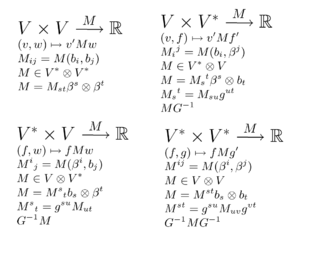Bilinear map
In mathematics, a bilinear operator is a function combining elements of two vector spaces to yield an element of a third vector space that is linear in each of its arguments. Matrix multiplication is an example.
Definition
Let V, W and X be three vector spaces over the same base field F. A bilinear map is a function
- B : V × W → X
such that for any w in W the map
- v ↦ B(v, w)
is a linear map from V to X, and for any v in V the map
- w ↦ B(v, w)
is a linear map from W to X.
In other words, if we hold the first entry of the bilinear map fixed, while letting the second entry vary, the result is a linear operator, and similarly if we hold the second entry fixed. Note that if we regard the product V × W as a vector space, then B is not a linear transformation of vector spaces (unless V = 0 or W = 0) because, for example B(2(v,w)) = B(2v,2w) = 2B(v,2w) = 4B(v,w).
If V = W and we have B(v,w) = B(w,v) for all v, w in V, then we say that B is symmetric.
The case where X is F, and we have a bilinear form, is particularly useful (see for example scalar product, inner product and quadratic form).
The definition works without any changes if instead of vector spaces over a field F, we use modules over a commutative ring R. It also can be easily generalized to n-ary functions, where the proper term is multilinear.
For the case of a non-commutative base ring R and a right module MR and a left module RN, we can define a bilinear map B : M × N → T, where T is an abelian group, such that for any n in N, m ↦ B(m, n) is a group homomorphism, and for any m in M, n ↦ B(m, n) is a group homomorphism too, and which also satisfies
- B(mt, n) = B(m, tn)
for all m in M, n in N and t in R..
Properties
A first immediate consequence of the definition is that B(x,y) = 0 whenever x = 0 or y = 0. (This is seen by writing the null vector 0 as 0·0 and moving the scalar 0 "outside", in front of B, by linearity.)
The set L(V,W;X) of all bilinear maps is a linear subspace of the space (viz. vector space, module) of all maps from V×W into X.

If V, W, X are finite-dimensional, then so is L(V,W;X). For X = F, i.e. bilinear forms, the dimension of this space is dim V × dim W (while the space L(V×W;F) of linear forms is of dimension dim V + dim W). To see this, choose a basis for V and W; then each bilinear map can be uniquely represented by the matrix B(ei,fj), and vice versa. Now, if X is a space of higher dimension, we obviously have dim L(V,W;X) = dim V × dim W × dim X.
Examples
- Matrix multiplication is a bilinear map M(m,n) × M(n,p) → M(m,p).
- If a vector space V over the real numbers R carries an inner product, then the inner product is a bilinear map V × V → R.
- In general, for a vector space V over a field F, a bilinear form on V is the same as a bilinear map V × V → F.
- If V is a vector space with dual space V*, then the application operator, b(f, v) = f(v) is a bilinear map from V* × V to the base field.
- Let V and W be vector spaces over the same base field F. If f is a member of V* and g a member of W*, then b(v, w) = f(v)g(w) defines a bilinear map V × W → F.
- The cross product in R3 is a bilinear map R3 × R3 → R3.
- Let B : V × W → X be a bilinear map, and L : U → W be a linear map, then (v, u) ↦ B(v, Lu) is a bilinear map on V × U.
- The null map, defined by B(v,w) = 0 for all (v,w) in V × W is the only map from V × W to X which is bilinear and linear at the same time. Indeed, if (v,w) ∈ V × W, then if B is linear, B(v,w) = B(v,0) + B(0,w) = 0 + 0 if B is bilinear.
See also
External links
- Hazewinkel, Michiel, ed. (2001), "Bilinear mapping", Encyclopedia of Mathematics, Springer, ISBN 978-1-55608-010-4
| ||||||||||||||||||||||||||